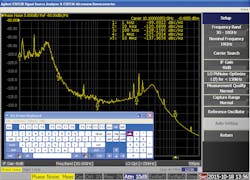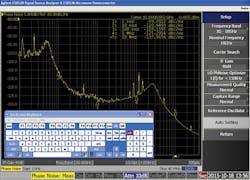This file type includes high-resolution graphics and schematics when applicable.
Frequency stability—an essential parameter for most RF/microwave applications—is usually synonymous with a signal source capable of low noise levels. The PHS-8400 family of frequency synthesizers from Pronghorn Solutions exemplifies a line of stable signal sources, but with a unique twist: The synthesizers are available in three different form factors—benchtop, modular, and handheld configurations—that will literally fit any application. Even better, they achieve low levels of harmonics, spurious, and phase noise across a standard frequency range of 0.7 to 24.0 GHz, with options to further extend that range.
The modular versions of the frequency synthesizers, such as a model PHS-8400M (Fig. 1), show how the small size does not force users to sacrifice flexibility. In addition to the expected interconnections for dc power and RF output signals, the frequency synthesizers include a modulation/trigger input, an input/output port to use an external frequency reference or access signals from the PHS-8400M’s internal frequency reference, and even a Universal Serial Bus to control the synthesizer with the appropriate software on a personal computer (PC). The model numbers for the rack-mountable benchtop and miniature handheld versions reflect their different form factors, PHS-8400B and PHS-8400H, albeit with the same performance levels provided in all three forms.
Such performance includes a frequency range that’s customizable according to specific requirements. The basic or “starting” frequency range is 0.7 to 24 GHz, but it can also start at 10 MHz, 0.5 GHz, or 1 GHz and stop at 12, 18, 24 GHz or higher, depending on the customer’s needs. The standard tuning resolution is 1 kHz, although this, too, can be changed, with options for frequency-tuning resolution of 1 or 0.01 Hz.
Stability Specifics
As noted, these are stable signal sources, with standard frequency stability of ±10 ppm. They can be supplied with a 10- or 100-MHz internal crystal oscillator frequency reference and work with an external frequency reference.
As expected for a stable source, the noise levels are low, with single-sideband (SSB) phase noise of less than –120 dBc/Hz offset 100 kHz from a 10-GHz carrier and better than –111 dBc/Hz offset 100 kHz from a 24-GHz carrier. Measurements with a commercial phase-noise analyzer from Keysight Technologies reveal that the phase noise at 10 GHz remains low for offsets closer to the carrier (Fig. 2). Spurious output is less than –60 dBc. Harmonics and subharmonics are held to less than –15 dBc, with options for harmonics and subharmonics of –40 dBc or less.
The PHS-8400 frequency synthesizers deliver at least +5 dBm output power across the full frequency range, with +7 dBm or more output power through 18 GHz. The power level can be controlled over a 10-dB range, in 0.5-dB increments. For applications requiring fast frequency switching speeds, the synthesizers can switch between two frequencies in list mode in less than 100 µs.
All three versions of the synthesizer include USB ports, and they ship with software drivers for control with a PC, including popular LabView instrument drivers from MathWorks. The benchtop and handheld models include displays and keypads, while benchtop and modular versions offer SCPI/IVI-compatible SPI and LAN interfaces as options. The synthesizers require a supply of +7.5 to +8.4 V dc and less than 1 A typical current. Power consumption for the modular synthesizer is typically less than 8 W, with a power-saver/standby mode available as an option to further conserve power. The modular synthesizer version (PHS-8400M) measures just 6.00 × 3.54 × 0.70 in. and weighs less than 1 lb.
Pronghorn Solutions, 4610 South Ulster St., Suite 150, Denver, CO 80237; (720) 808-9832, e-mail: [email protected].
About the Author
Jack Browne
Technical Contributor
Jack Browne, Technical Contributor, has worked in technical publishing for over 30 years. He managed the content and production of three technical journals while at the American Institute of Physics, including Medical Physics and the Journal of Vacuum Science & Technology. He has been a Publisher and Editor for Penton Media, started the firm’s Wireless Symposium & Exhibition trade show in 1993, and currently serves as Technical Contributor for that company's Microwaves & RF magazine. Browne, who holds a BS in Mathematics from City College of New York and BA degrees in English and Philosophy from Fordham University, is a member of the IEEE.



